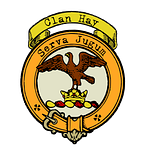Welcome back to the "A Clan A Day Podcast," brought to you by bagtownclans.com. I'm your host, Colin MacDonald, and today we’ll be exploring the captivating story of Clan Calder, a Highland clan with deep roots in Scotland's history and a legacy intertwined with some of the nation's most powerful families. Despite challenges to their rise, the Calder name has persevered, leaving a mark on both the Scottish landscape and historical memory.
The name Calder is believed to derive from a Scots word for a small stream, but it might also have older origins. Some scholars trace it to the ancient Brittonic language, suggesting it means "hard or violent water," similar to the modern Welsh word "caled," meaning "hard." This evocative description fits the many rivers and streams that bear the name across Scotland, such as East Calder and West Calder near Edinburgh, and Calderwood near Glasgow. It is a name that speaks to the rugged, untamed beauty of the Scottish landscape that the Calders called home.
The Calder lineage rose to prominence with Hugo de Cadella, a French knight believed to be the clan's progenitor. Hugo was granted the title of Thane of Calder (later known as Cawdor) by the Scottish crown, establishing his family in Nairnshire. Over time, the Calder family amassed considerable influence and land, particularly around Inverness. Historical records show that by 1178, a Hugh de Kaledouer had already emerged as a notable figure, serving as a witness to a land charter near Montrose.
The Calders continued to thrive, and in 1454, they built the tower at Cawdor Castle, a testament to their power and influence. This stronghold, which still stands today, became the heart of the Calder family’s domain, offering both defense and a symbol of their noble status.
As with many clans, the Calders sought to consolidate their power through strategic marriages. They forged alliances with other influential families, such as the Rose family, Barons of Kilravock, a union that further strengthened their foothold in the Highlands. These alliances helped the Calders rise to even greater prominence, but this rise would also attract powerful adversaries.
A key turning point in Calder history came with the tragic and dramatic story of Muriel Calder, the infant heiress of the Calder family. After the death of her father, Muriel became the center of a power struggle. Archibald Campbell, the 2nd Earl of Argyll, was appointed as her guardian, along with Hugh Rose of Kilravock. The Earl had his own ambitions for Muriel, hoping to bring her to Inverary, the seat of Clan Campbell, and raise her as part of his family.
However, Muriel's uncles, Alexander and Hugh Calder, fiercely opposed this plan. Determined to keep Muriel within the Calder fold, they chased the Campbell party across Strathnairn, leading to a bloody confrontation that claimed many lives. Despite their best efforts, Muriel was eventually taken to Inverary. The Campbell's victory in this struggle marked a significant blow to the Calder clan’s autonomy.
Raised as a Campbell, Muriel would eventually marry Sir John Campbell, the son of the Earl of Argyll, effectively sealing the fate of the Calder family. Though Muriel's death around 1575 marked the end of the Calder chiefs in the direct line, the Calder name did not disappear. Through marriage, the Calders of Cawdor became integrated into the Campbell family, and their descendants, the Campbells of Cawdor, would continue to hold power and influence.
One of Muriel’s descendants, John Campbell of Cawdor, was elevated to the peerage as Lord Cawdor in 1796, and his son became the first Earl of Cawdor in 1827. Even today, the Earl of Cawdor continues to reside at Cawdor Castle, a living link to the Calder family’s rich history.
But the story of the Calders doesn’t end there. Though the direct line of Calder chiefs was subsumed by the Campbells, other branches of the family continued to thrive. One such branch, the Calders of Asswanly, received lands near Elgin in 1440. This family would go on to secure a baronetcy of Nova Scotia in 1686, and one of its most famous members, Robert Calder, made a name for himself during the Napoleonic Wars, where he distinguished himself in naval battles.
The Calder name lived on in the 20th century as well. During World War II, Sir James Calder served as an advisor to the Ministry of Supply, contributing to the war effort in a vital capacity. Meanwhile, in the field of architecture and urban planning, Douglas Calder served as the President of the Royal Incorporation of Architects in Scotland and became a key figure in shaping the future of the Scottish Highlands as the Director of Planning for the new Highland Region in 1974.
Though the Calder family no longer has a clan chief and is considered an armigerous clan, their legacy remains strong. Cawdor Castle, with its storied walls and centuries of history, continues to be a focal point for those who seek to understand the Calder legacy. Visitors to the castle can walk in the footsteps of the clan’s ancestors, from the building of the central tower to the dramatic struggles that shaped the future of both the Calder and Campbell families.
So, while the Calder name may no longer ring out in the halls of clan chiefs, it endures in the landscape of Scotland itself, in the castle that still bears their name, and in the many rivers and streams that echo the meaning of their name—"hard water"—a fitting metaphor for a family that weathered the storms of Scottish history.
That wraps up today’s episode of "A Clan A Day Podcast." Thanks for joining me on this journey through the history of Clan Calder. Be sure to tune in tomorrow as we explore another chapter of Scotland’s rich clan heritage. I'm Colin MacDonald, and as always, Go n-éirí an bóthar leat.











